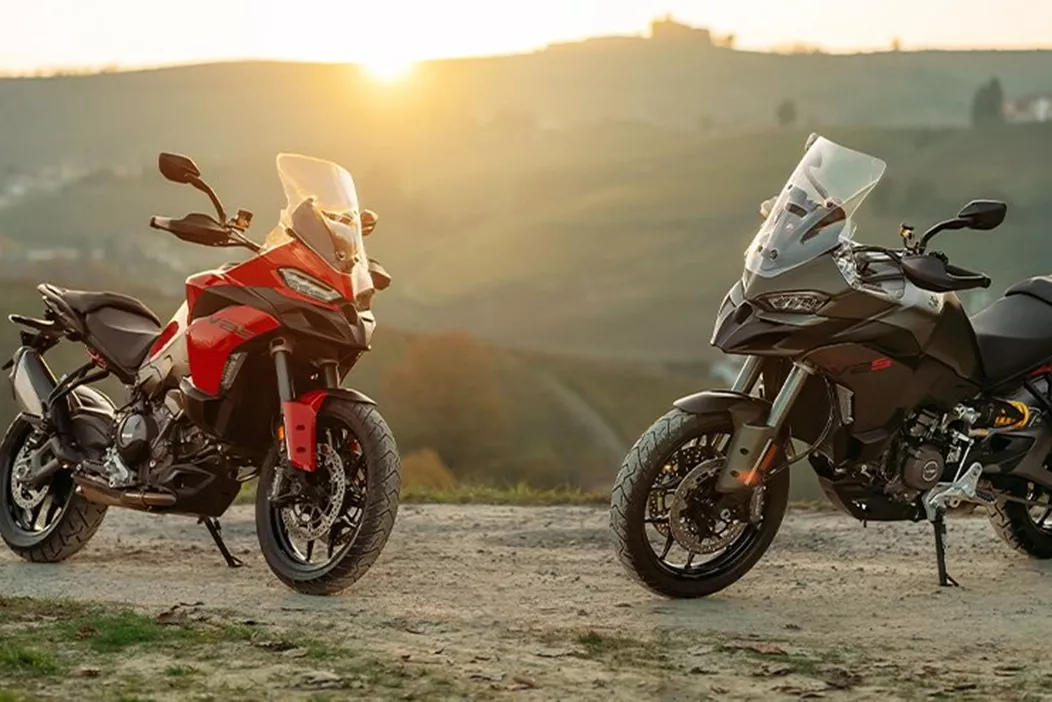While the last update to the "small" Multistrada in 2021 was rather sparing with innovations, the latest model update could almost be described as groundbreaking. According to Ducati engineers on-site, the 2025 variant shares only about five percent of its components with the previous model. Naturally, the centerpiece of the overhaul is the new 890cc V2 engine, which no longer relies on desmodromic valves but instead adopts variable valve timing. This aims to achieve a smoother power delivery at low revs. At the same time, peak power has been increased from 113 to 115.6 hp at 10,750 rpm, while maximum torque has been reduced by 2 Nm. The peak now stands at 92 Nm at 8,250 rpm. However, the predecessor reached its torque peak at just 6,750 rpm, a fact that raises some concerns. Does the new Multistrada now require higher revs to deliver satisfactorily? Fortunately, this question was clearly answered during the test ride, and you'll find the resolution further down.

Ducati Multistrada V2 S 2025 - First Ride Review!
How Does the New V2 Engine Perform?
The anticipation for the first test of the new Ducati Multistrada V2 is particularly high this time, as the sport-touring machine has been almost completely redesigned for the 2025 model year! During the initial ride in Valencia, Schaaf is set to discover how the new engine and all the other updates feel on the road!
&width=72&height=72&bgcolor=rgba_39_42_44_0&mode=crop)
Schaaf
published on 03/02/2025
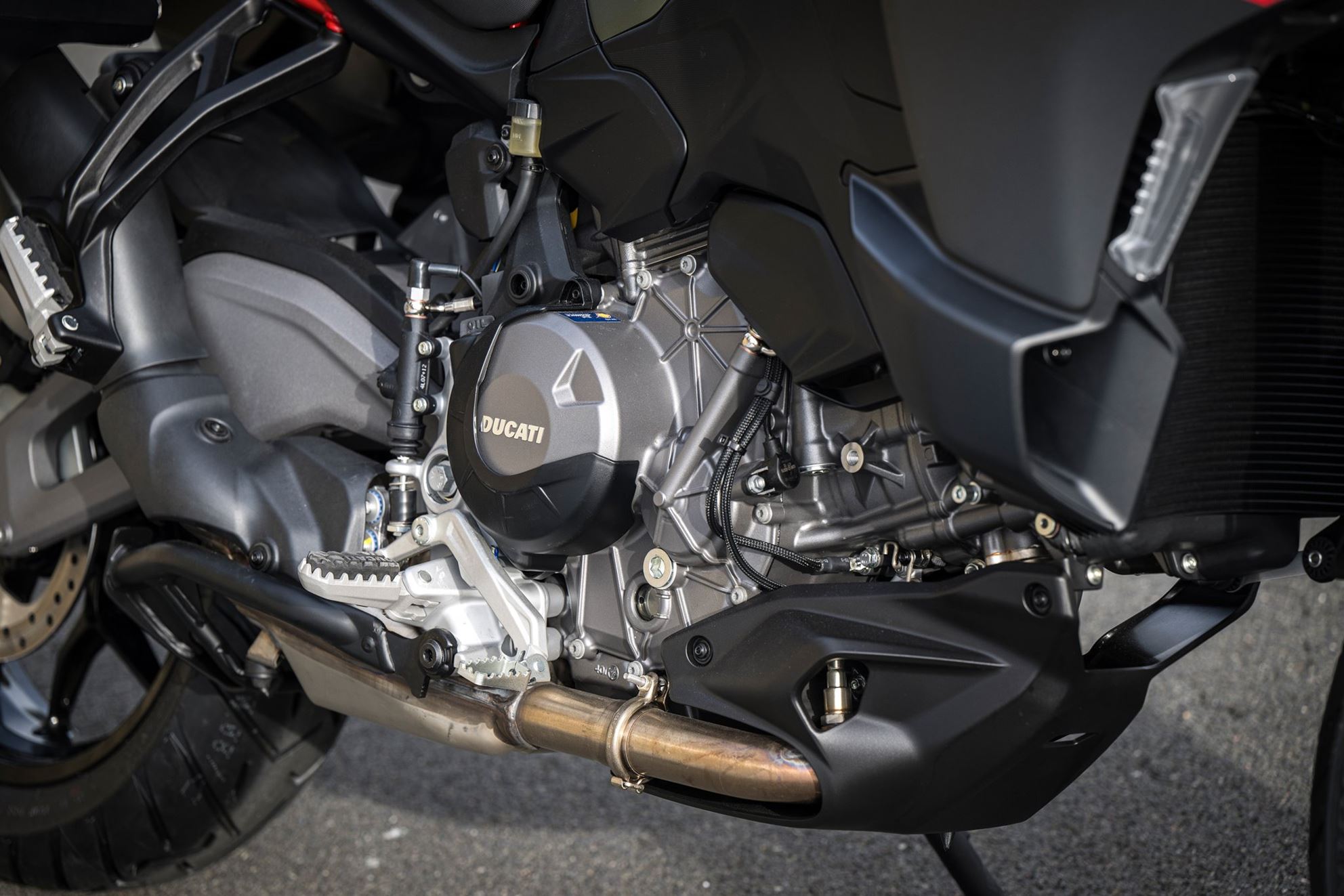
The Completely Redesigned V2 Engine
Even though the desmodromic system is gone, the maintenance intervals remain unchanged: oil changes are required every 15,000 kilometers, and a valve clearance check is due every 30,000 kilometers. The primary focus in the redevelopment of the Multistrada was on weight reduction. Alongside the engine, which at 54.9 kg is the lightest Ducati V2 to date, the new chassis construction significantly contributes to the successful weight loss. An aluminum monocoque, a load-bearing engine, and a bolted steel subframe now form the framework. The swingarm is also new, as are the wheels, which are collectively 1.5 kg lighter. Overall, the new model is set to weigh in at a whopping 18 kg less. The ready-to-ride standard version weighs 199 kilograms without fuel, while the tested S version is another 3 kg heavier. The tank, by the way, can hold up to 19 liters of fuel.
Ergonomic Changes
There have been several changes in the area of ergonomics as well. The suspension travel of 170 millimeters front and rear remains unchanged, but the seat height is now adjustable in two stages. It is standardly set between 830 and 850 millimeters but can be lowered to as low as 790 millimeters or raised to a maximum of 870 millimeters with optional accessories. Additionally, Ducati offers a lowering function that allows the bike to be lowered by another eight millimeters at the push of a button, making life easier for shorter riders when coming to a stop.
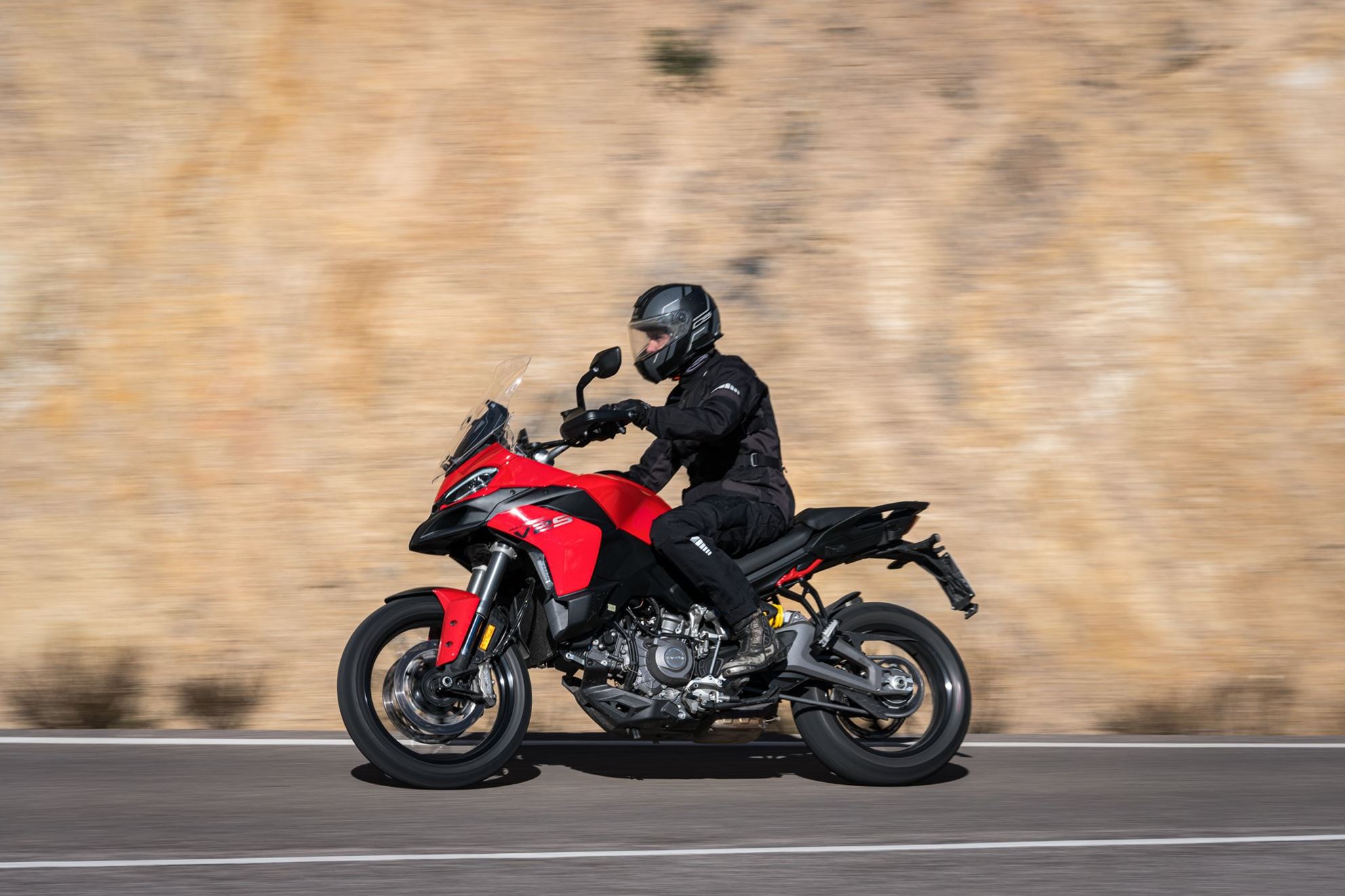
Ergonomic updates aim to make the new Multi V2 even more accessible!
The Multistrada V2 S is, of course, equipped with the latest electronics. It features a comprehensive electronics package that includes cornering ABS and lean-sensitive traction control. Five pre-configured and individually adjustable riding modes allow you to tailor throttle response, wheelie control, engine braking, ABS, and traction control to your personal preferences. The semi-active suspension can be electronically adjusted in five stages and now also offers pre-set electronic setups labeled as Dynamic, Comfort, and Low Grip.
Differences Between S and Standard, Available Colors, Pricing
In the saddle of the more affordable standard variant without the "S," you'll forgo the semi-active suspension and the Ducati Multimedia System, making it about 2,000 euros cheaper. An interesting decision by Ducati is that even the S version doesn't come with heated grips as standard. These are only available in the Travel package, which is currently priced at 1,225 euros and also includes 60-liter side cases and a center stand. The respective extras can, of course, be purchased separately and without the package. The accessories catalog also offers further worthwhile investment options, such as the obligatory Termignoni slip-on, aluminum cases, top case, engine guard, crash bars, or wire-spoke rims. In terms of color options, the standard version is only available in red, while the "S" also offers a military-inspired green. There’s good news for A2 license holders as well—the Multi is available in a restricted version. You can find the current prices for Germany here, as well as those for Austria and Switzerland.
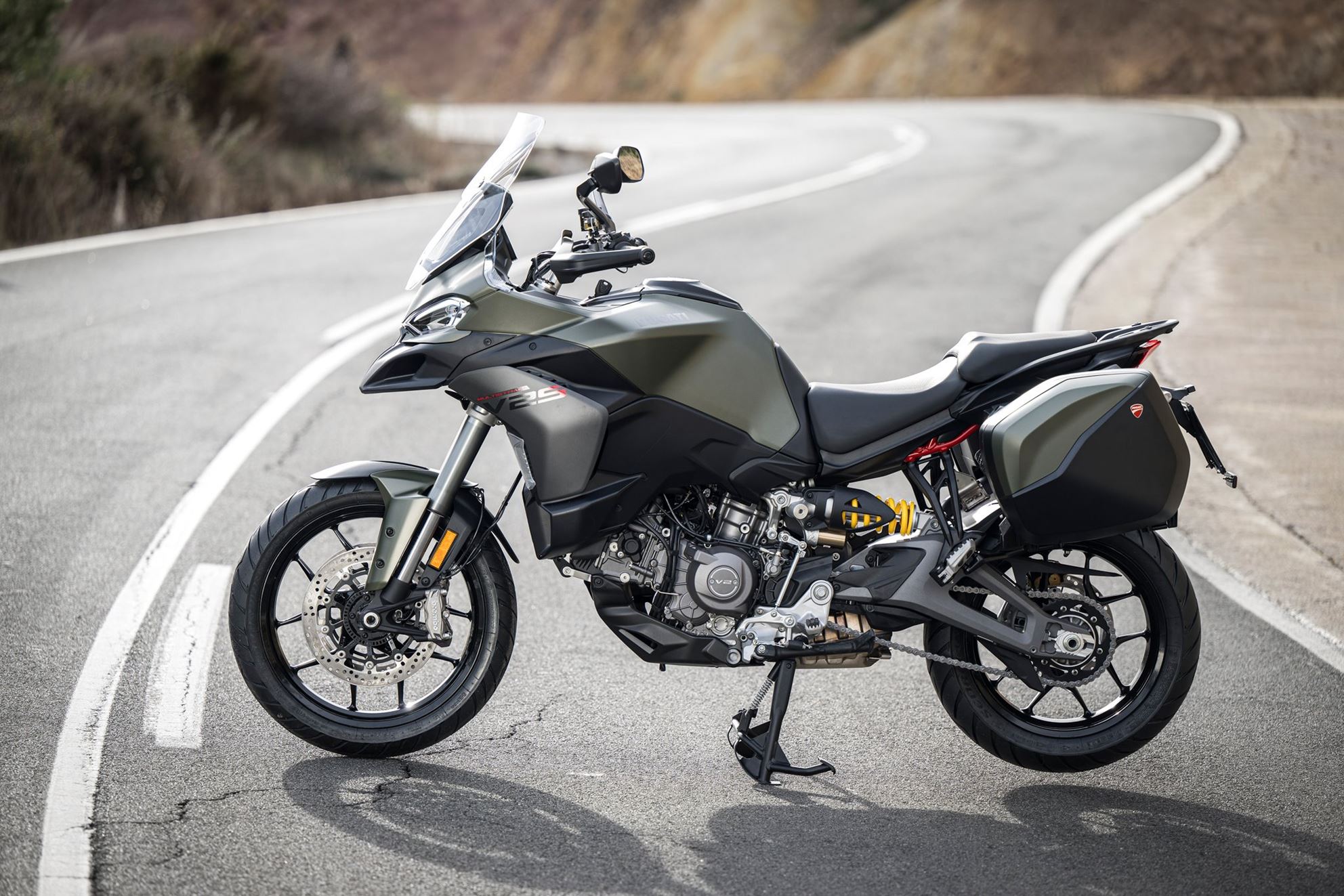
The Multistrada V2 S in Travel Trim
An inevitable question with the new model generation is whether Ducati has sacrificed the distinctive charm of its engines with the removal of the desmodromic system. This engine character, the unmistakable feel in the saddle, the vibrations, and the specific riding behavior have always been essential for many Ducati fans. Personally, I even find the somewhat unruly behavior of the old Multistrada at low revs to be somewhat endearing. So, in addition to my concerns about the late-arriving peak performance, there's also the worry about losing that unique Ducati feel. You'll find the answer to that further down in the report, although I must point out that my response is far less clear-cut.
Ergonomics of the 2025 Ducati Multistrada V2 S
I’ll start the actual ride report with the ergonomics, as quite a bit has changed here too. The seating position feels more touring-oriented, aligning more with the adventure touring average. According to Ducati, the knee angle has been made more relaxed, and it’s noticeable that the seating feels less integrated into the motorcycle overall. You sit more on top of the bike than in it, which actually suits an active riding style better. While the knee angle is less acute, you can still easily get your upper body over the handlebars. You feel in control, not like a passenger. The seat feels premium and offers enough freedom of movement to shift into different positions by sliding back and forth. It tends to be on the firmer side, which could be beneficial on longer rides. While riding, it’s noticeable that vibrations are minimal. Neither the handlebars nor the footpegs transmit any disturbing vibrations, which supports a more comfortable and stress-free journey.
Wind Protection of the 2025 Ducati Multistrada V2
The front now resembles the Multistrada V4 more closely, which naturally brings changes to the wind protection. In its highest position, the windscreen fully shields the rider's head from turbulence, while in its lowest setting, it allows for a pleasant breeze. This keeps noise levels in a comfortable range. According to Ducati, the new front also improves wind protection around the shoulder area. It might indeed be better than on the previous model, although I’d refrain from drawing a final conclusion without a direct comparison. At least I didn't notice any unpleasant draft on my shoulders. However, there is definitely some airflow on the arms, which isn't surprising given the bike’s relatively sleek profile. An interesting new feature is the aerodynamic channels for the legs, intended to provide better cooling in summer. During the cooler temperatures of the test, however, they primarily resulted in cold legs, as there is no way to regulate the airflow. An adjustment in the next model generation would be desirable here. Regardless, I didn't notice any uncomfortable heat from the engine during the test ride. How it performs in much warmer conditions remains to be seen.
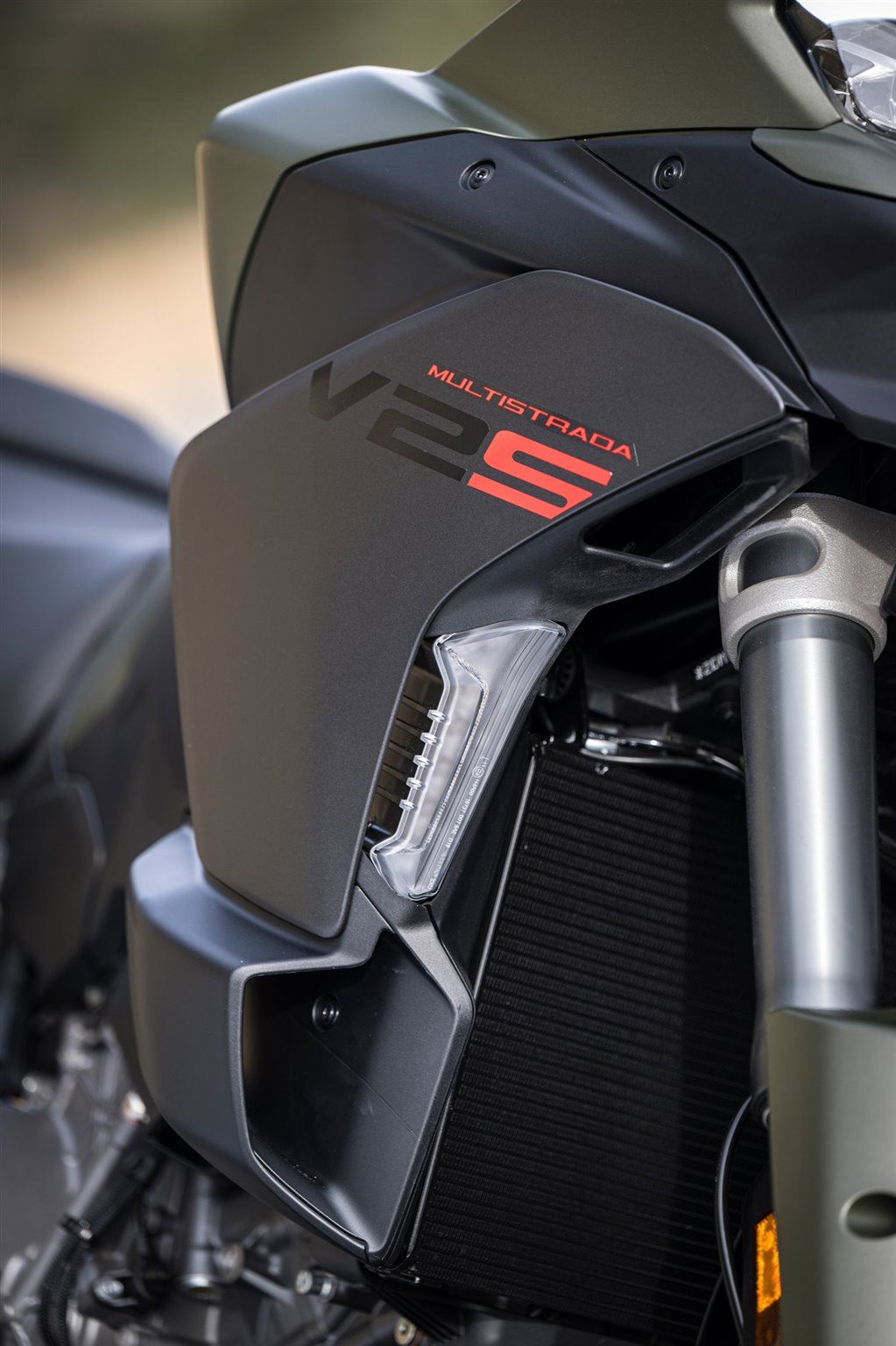
The new air intakes are designed to keep your legs cool.
The new Multistrada V2 S now features three different display modes. The first option offers a clean and minimalist layout, while the second provides a bit more information, such as displaying the current torque and power. The third display is much more comprehensive, though some riders might find it a bit cluttered. An interesting addition to this view is the ability to adjust electronic aids like traction control, engine braking, or ABS directly using the left joystick while riding. This is a welcome change, though the interface might not be considered entirely intuitive.
Switching the riding mode not only requires pressing the mode button once but also involves additional navigation and confirmation with the joystick. The purpose of having a dedicated MODE button, yet still needing extra button presses, seems somewhat illogical.
On the other hand, the placement of the USB port is quite sensibly chosen, located inside the left front fairing. However, opening the compartment does require a bit of finesse.
Riding the Multistrada V2 at Low Speeds
From the first take-off, the Multistrada V2 S feels very well-balanced. Even at walking speeds, the motorcycle inspires a lot of confidence. The clutch engages relatively late, but it can be finely modulated, although it requires a bit more hand strength compared to some other bikes in this class. While the predecessor ran consistently rough and uneven at low revs, this issue has now been completely resolved. From as low as 2,000 rpm, the engine runs smoothly and allows for seamless acceleration. From now on, cruising at 50 km/h in fifth gear no longer feels out of place.
An Almost Perfect Quickshifter
The quickshifter also works flawlessly at lower revs, but one small drawback remains: unlike some modern quickshifters, it cannot upshift with a closed throttle. This would be particularly useful in city traffic, for example, when you want to coast after a short burst of acceleration and then switch to a higher gear. In such cases, you still need to use the clutch. Conversely, downshifting with an open throttle works perfectly, which is especially beneficial when overtaking.
The shifting feel itself has been successfully improved. While the gearbox of the old Multistrada felt clunky and notchy, the new V2 S shifts more precisely, with the unpleasant feel at the lever now a thing of the past. False neutrals between gears did not occur during the test, and neutral was also easy to find.
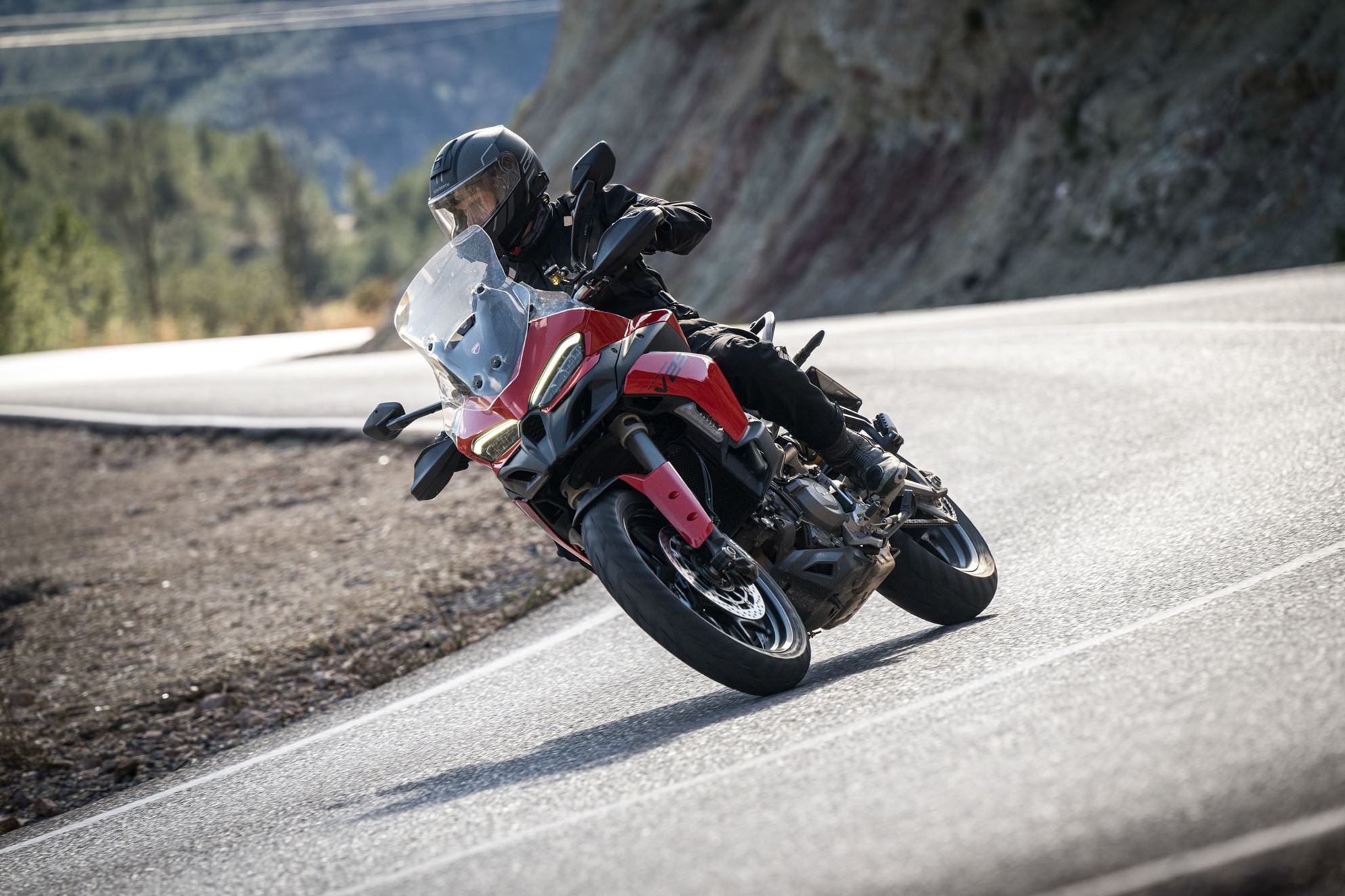
Gear shifts now feel significantly smoother
The handling at low speeds is also impressive. Despite its features, the Multi feels relatively light and can be maneuvered without much effort. The steering angle is sufficient, allowing even tight turn maneuvers to be executed without issue. Unfortunately, it wasn't possible to assess how easy or difficult it is to place the bike on the center stand, as the test motorcycles were not equipped with this practical touring feature.
The noise levels have improved compared to the previous model, at least concerning mechanical noise at low speeds, which is now barely noticeable. Overall, the sound is subtle and modern while retaining the distinctive V2 character.
Braking System of the 2025 Ducati Multistrada V2
The front brake is tuned for touring use. It is easy to modulate but requires a bit of lever travel before it bites hard. This suits a touring bike, as overly aggressive braking can be disruptive in city traffic or during relaxed riding. Some colleagues on-site felt the lever travel was too long, but personally, I found the behavior to be appropriate. The rear brake, however, was not as smoothly adjustable. It either barely responds or suddenly bites hard, which was particularly noticeable during slow riding.
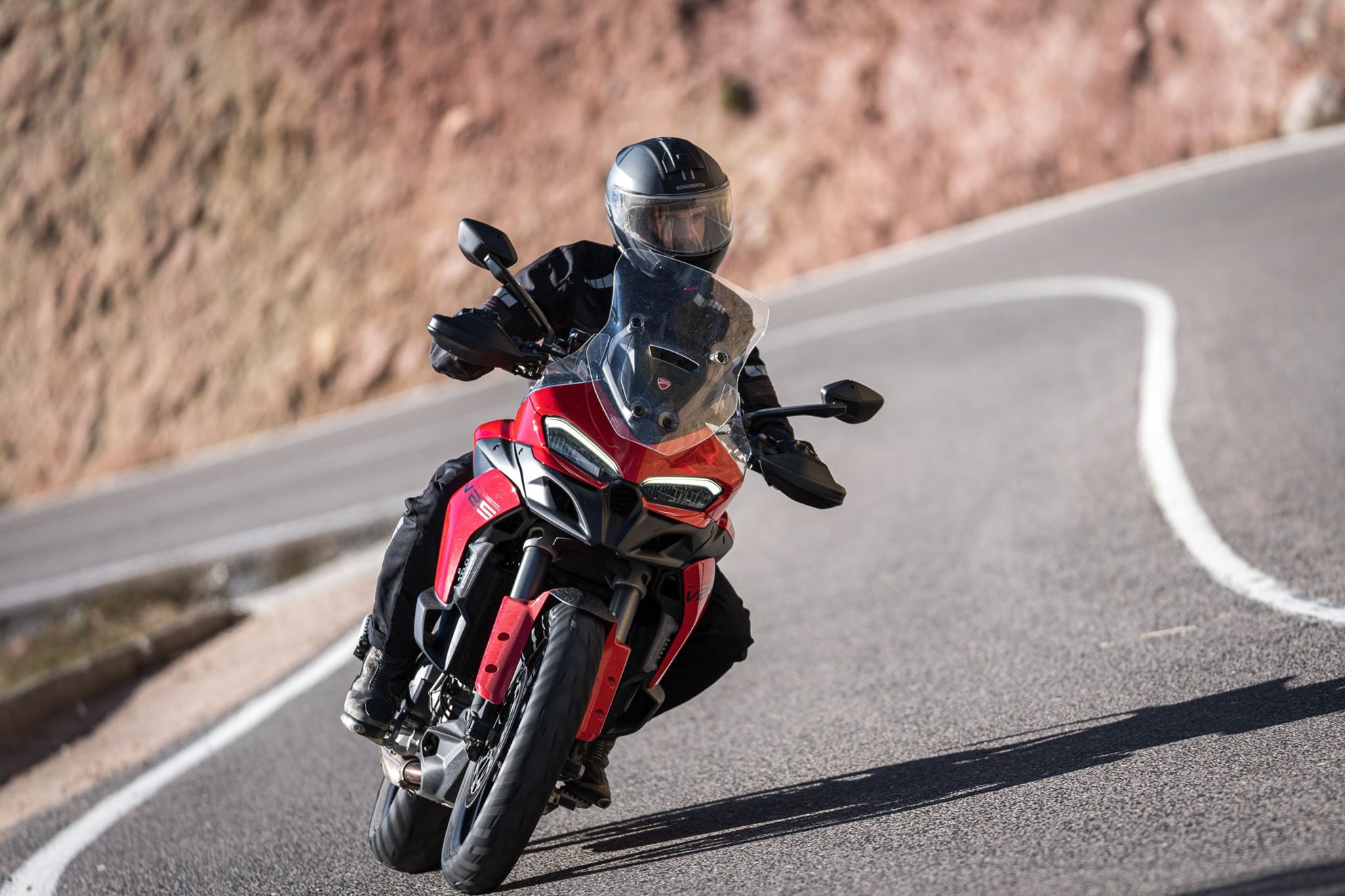
The front braking on the small Multi is perfect.
Another comfort feature is the previously mentioned lowering function, which reduces the spring preload to help shorter riders plant their feet securely. Operation is via a button press, requiring manual activation and deactivation. An automatic solution would have been desirable at this price point.
Suspension Details
The suspension remains one of the greatest strengths of the "small" Multistrada, with components that boast excellent responsiveness. It adeptly absorbs bumps and rough road surfaces without transmitting harsh jolts to the rider. The quality of the suspension elements is typically Ducati, at a high level, delivering a solid yet comfortable ride feel. The base setup is more on the sporty side, but not to the point of being uncomfortable.
The differences between the suspension modes—Dynamic, Comfort, and Low-Grip—are noticeable, though not as pronounced as one might expect. While the Comfort mode offers slightly softer damping, the inherent stable and precise character of the suspension is always maintained. It’s only when you further configure the suspension to "soft" or "softest" through the menu that the bike starts to exhibit a bit of wallowing in certain riding situations. However, even in the softest setting, it never becomes a mushy ride!
Riding Dynamics of the 2025 Multistrada V2 S
The excellent suspension combined with the new chassis results in truly impressive handling. The motorcycle can be leaned over effortlessly, inspiring confidence from the very first corner. Despite its stable road stance, it never feels sluggish or top-heavy, instead offering complete neutrality that impresses in both slow and fast riding conditions.
The V2 Multi has always been known for its agility, and this new model seems to take that to the next level. What stands out is the blend of suspension comfort, agility, and stability—a trifecta that Ducati has nearly perfected here. Even at high speeds, the bike remains calm and stable, even when quickly transitioning from one curve to the next. There's no wobbling, no nervousness, and all of this with consistently playful handling!
The front-end feel is still present. Despite a somewhat more comfortable seating position, the connection to the front remains intact, especially noticeable in wet or challenging road conditions. At least as much as one can expect from a crossover bike standing on 170mm legs.
Throttle Response and Quickshifter in Sport Riding
The quickshifter on the new Multistrada V2 S is noticeably faster during spirited riding than its predecessor, though not entirely flawless. At high RPMs, there might be the occasional slight stutter during a gear change, but overall, the system operates precisely and supports a sporty riding style. The throttle response, however, is absolutely impeccable. In Sport mode, power delivery is desirably direct yet smooth, with no jerks. For those who prefer a gentler approach, a less aggressive throttle response is available without making it feel artificially delayed. Ducatis of the recent generation have always excelled in throttle responsiveness, and this remains true with the new V2. There were no unpleasant or intrusive interventions from the traction control during the test ride either.
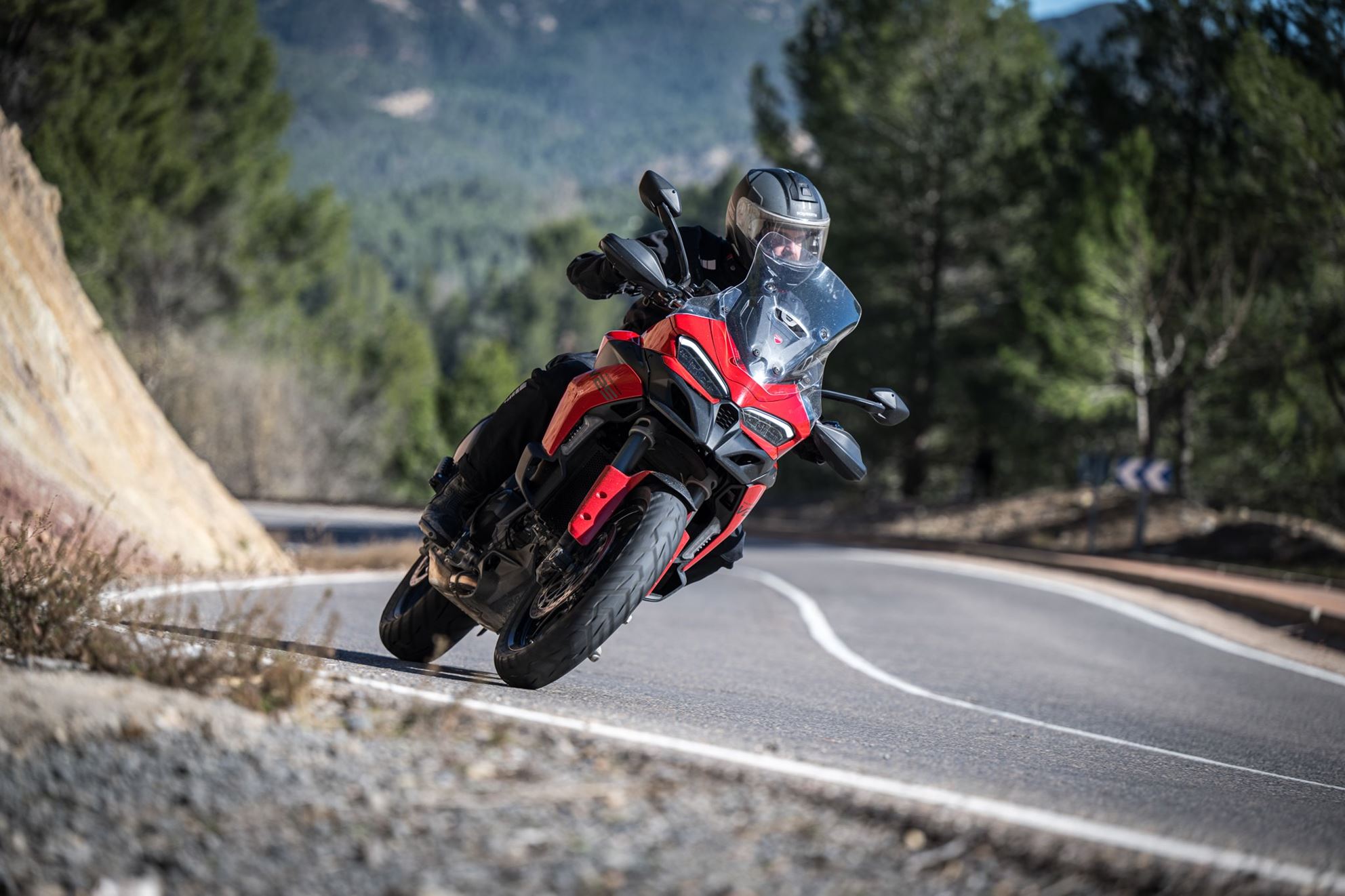
The Multistrada V2 still excels in sporty riding. Very much so.
The new power unit still delivers plenty of riding excitement and consistently powerful performance. From around 3,000 RPM, there is ample torque available, providing the desirable push that meets V2 expectations. But the power delivery doesn't stop there; those who rev the engine to its maximum will be rewarded with smooth and strong acceleration.
Despite this respectable performance, the power unit isn't a classic "torque monster" for low-rev cruising, likely due to its capacity. On twisty roads, you can ride without frequent shifting smoothly, though there might be brief moments of lacking thrust if you drop below 3,000 RPM. So, engines with more displacement certainly still have their place!
Sound of the 2025 Ducati Multistrada V2
The sound of the new Multistrada V2 S is a double-edged sword. The typical V2 rumble is still there but not overly intrusive. Those who prefer a quieter ride will appreciate that the Ducati can be ridden calmly and unobtrusively. However, what's missing is the distinctive intake roar of the predecessor. While the old Multi impressed with an exhilarating sound from the airbox, the new engine's intake noise is rather unspectacular at higher revs. It's a detail that might seem less important in everyday motorcycling but still significantly contributes to the bike's character. Other manufacturers are currently better at making the intake noise a true sound highlight!
The Multistrada V2 Off-Road Performance
The Multistrada V2 S might be a road-oriented crossover bike, but Ducati has still equipped it with some off-road genes. Light gravel paths pose no problem, as the suspension travel is more than adequate for such terrain. The standing position feels comfortable, with a decent contact area for the legs. However, those wanting to lean further forward will quickly find their movement restricted by the nicely shaped tank, making it clear that it's not built for serious off-road adventures. Interestingly, despite its road-focused design, Ducati allows the ABS to be disabled not just at the rear but also at the front, which could be appealing for those who want to tackle more challenging gravel sections. Additionally, there are two dedicated traction control settings for off-road use.
Minor Flaws in Build Quality
The Ducati Multistrada V2 S remains a relatively expensive motorcycle. When a manufacturer demands such a price, one can reasonably expect high standards in build quality and detail solutions. Ducati gets many things right, with elegantly shaped mirrors, classy-looking Brembo levers, and an appealing swingarm. However, there are criticisms as well. On the left side, there are many exposed cables, despite a large plastic cover likely intended to mask the issue. Unsightly connectors and colorful cable ends are visible, where a simple heat shrink could have conveyed a much more premium impression. The fit of some plastic parts isn't quite at the level one would expect in this price range. Gaps and transitions sometimes feel more mid-range than premium.
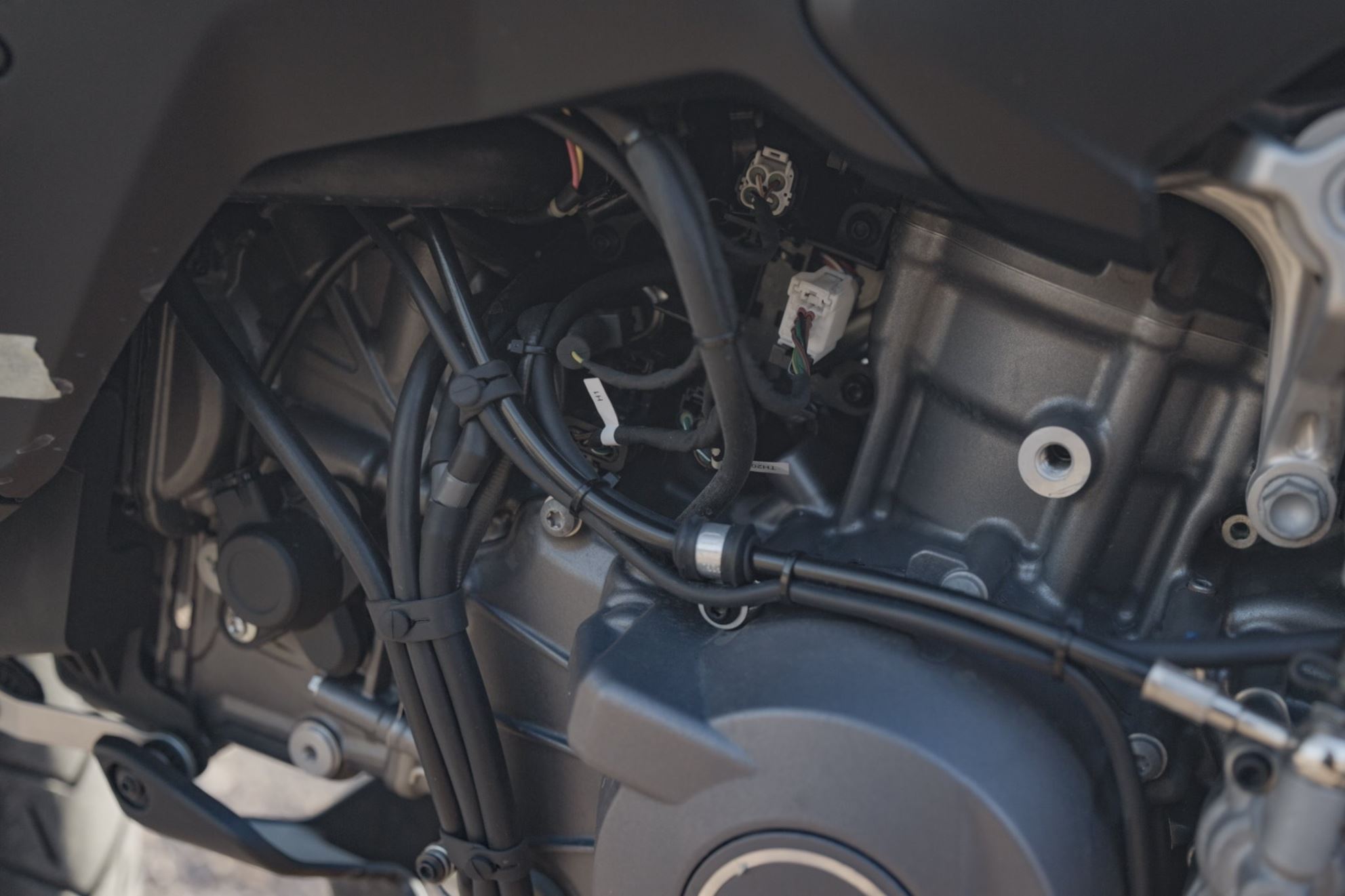
The left side looks a bit untidy.
Perhaps this particular type of craftsmanship adds to the allure of the brand for some fans, but in most cases, it's primarily the engines of the Bologna bikes that are responsible for the famous Ducati character. So, regarding the latest V2 from Italy, were my initial concerns justified?
The New V2 - Concerns and Considerations
One of the two questions can be answered definitively: the late-arriving peak torque is no issue at all. The engine certainly delivers satisfactorily. However, regarding its character, my answer isn't quite as clear-cut.
In almost every aspect, the new model is a significant advancement! The rough behavior at low revs is a thing of the past, the gearbox operates more smoothly, and the electronics and suspension remain top-notch.
This also makes it clear that the quirks, which I found endearing, are now gone. Is that a bad thing? Objectively, certainly not. Anyone riding a Multistrada V2 still gets—and now even more so—a bike that handles playfully and remains stable in every riding situation. The handling, performance, and quality of the new engine surpass the predecessor in every way.
However, dedicated Ducati fans might find that the new model has lost some of its former idiosyncrasy. So, if you loved that particular, somewhat quirky nature, you might miss the old character. Yet, objectively speaking, the 2025 version is a better motorcycle in every respect. The price increase is justified by the quality offered, and no one will be disappointed. Those seeking the best mix of sportiness and long-distance capability are still well-served with a Ducati Multistrada V2 S!
- How much does a Ducati Multistrada V2 S cost?
- Here you will find an overview of the price level of new and used motorbikes!
&width=60&height=60&bgcolor=rgba_39_42_44_0&mode=crop)
Ducati Multistrada V2 S 2025 - Experiences and Expert Review
Schaaf
The numerous changes have paid off; the 2025 Ducati Multistrada V2 S is better than ever! The rough behavior at low revs is gone, and the gearbox now works significantly better. If you're looking for the ultimate compromise between sportiness and touring capability, the "small" Multi is a fantastic choice!
Mehr zu sportlichen Reise-Motorrädern:
Ducati Multistrada V2 S 2025 - First Ride Review! Images
Source: 1000PS























































































































